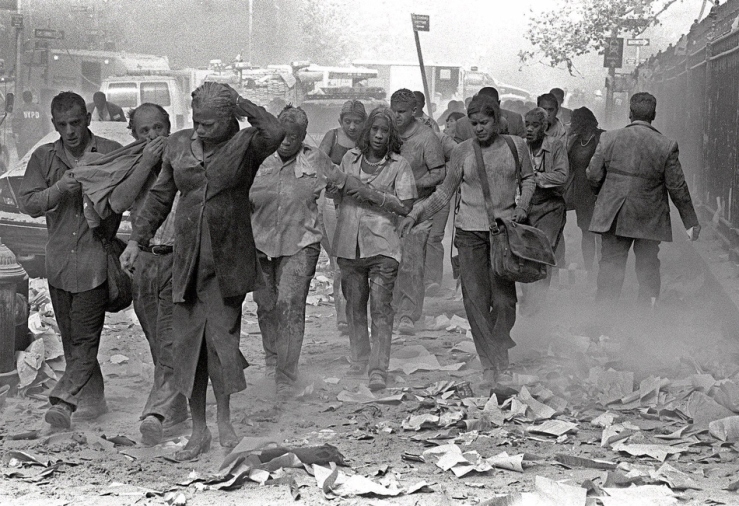Iconic Photos looks back at the most powerful images from the day that created thousands of them.

Apart from annual national holidays, history scarcely invokes events by the dates on which they occurred, but September 11 immediately joined the Fifth of November and the Ides of March as a day that would forever live in infamy.
And this month, newspapers, magazines and blogs will commemorate the tenth anniversary of that harrowing day. Some will be personal and introspective, others will invoke history’s long arc, and we at IP will take a photographic trip down the memory lane back to that September morning everyone claims he remember vividly.
There are two approaches and two parts to this retrospective. In the first part today, we will try to forget the Pandora’s Box that epochal day opened; imagine you know nothing about the Afghan and Iraq Wars; the Patriot Act; the missing WMDs; wiretappings, Gitmo and secret renditions; Abu Gharib; Madrid and London attacks; bin Laden’s demise or countless politicians and pundits hijacking the memory of 9/11. Then, the photos posted below will tell you the Story of 9/11 without the thick lenses of the future distorting their historical present.
Lead photo: Robert Clark saw the second plane approaching the WTC from his rooftop in Willimasburg, Brooklyn; For these four photos, Clark won the World Press Award.
*

Many photographers were in New York, covering the U.S. Open and the NY Fashion Week. Also, two photographic legends, Steve McCurry and James Nachtwey were also coincidentally in town. For Time magazine, Nachtwey took some of the most powerful images of the day, including the photo above.
*

New York Post’s Bolivar Arellano was just beneath the South Tower when it came crashing down.
*

Bill Biggart heard that the first plane crashed into the WTC on the radio; he rushed to the site, and documented the devastation until the North Tower collapsed and buried him. He was the only photographer killed during the attack. His camera and film were recovered, published in Newsweek on October 19th 2001. They are now in Newseum.
*

Suzanne Plunkett was covering the DKNY fashion show that morning. She raced to the Ground Zero, and as she emerged from the subway at Fulton Street, the towers came down. She took powerful images of panicked people running just before the dustcloud overtook her. She ran for her life hid under a car.
*

Father Mychal Judge, the New York Fire Department’s beloved chaplain became the most famous victim of the attacks. Judge entered the North Tower after administering the Last Rites to the people lying on the streets. Shannon Stapleton (Reuters) took the touching photo of Judge’s body being carried out of the rubble by five men, which instantly became known as American Pieta.
*

Amy Sancetta was enjoying a day off from covering the U.S. Open; on hearing the attacks, her first thoughts were, “Oh, great. Some guy has driven his little twin-engine plane into the trade center, and it’s going to take up my whole day off in the city.” She was justified in this reasoning, for in 1945, just that happened at the Empire State Building. She arrived as the South Tower collapsed and the debris cloud overtook her. After hiding in a parking garage, she emerged back into a “winter wonderland of debris”, and took the above photo of a businessman emerging from the debris.
*

Gulnara Samoilova who lived just four blocks away from the WTC was awaken by the sirens. She entered the south tower, but quickly retreated, and was just outside it when it collapsed. In coming months, as an editor of AP Library, her job came to involve going through the 9/11 photos. Deeply haunted by her memories, she left the AP in 2003.
*

Officer Richard Adamiak yelled at Ruth Fremson after she took his photo as he caught his breath inside the Stage Door Deli.
*

Eight hours after the attack, three firemen took an American flag off a yacht and raised it in the wreckage. The moment, captured by Thomas E. Franklin, evoked the memories of Iwo Jima. A year after the attacks, Franklin reunited with the trio for a new photo, this time with the Statue of Liberty as the background. The flag, however, has since gone missing.
In an early attempt to memorialize the day, it was proposed to put up a statue of this moment outside NY fire department’s Brooklyn headquarters, but the proposal collapsed when the fire department (which was 94% white) objected to the proposal’s plan to change two of the white firemen in the photo to a black and a Latino for the statue.
*

This photo, allegedly recovered from the debris, showed a tourist standing on the viewing platform of the World Trade Center as the hijacked plane approaches. The photo was, in fact, a fake, created from a photo one Hungarian tourist named Péter Guzli took in 1997. Exposed, it became an early internet meme, with Guzli cameoing at many disasters.
*
.
Tomorrow, we will take a different approach. We will look back at the 9/11 photos that were controversial, and those that shaped the national discourse, while contemplating the morally, politically, militarily, and financially exhausting decade that 9/11 created.
As always, follow me on Twitter, and also, suggest your favorite iconic 9/11 photo in the comments below. Best.

